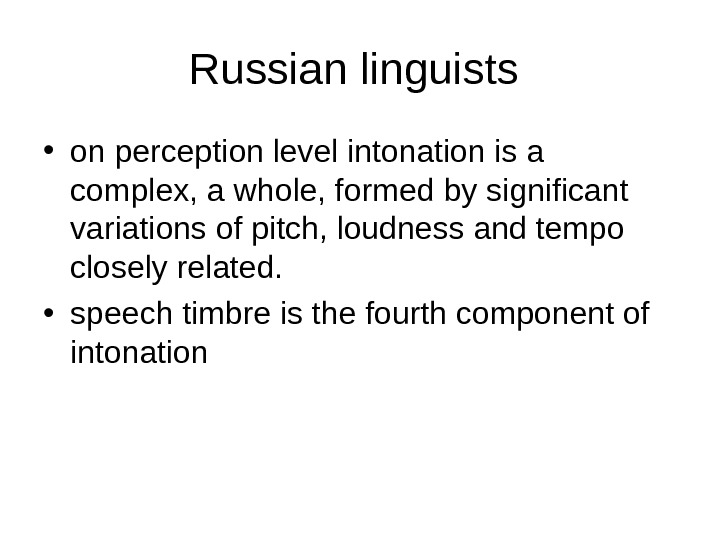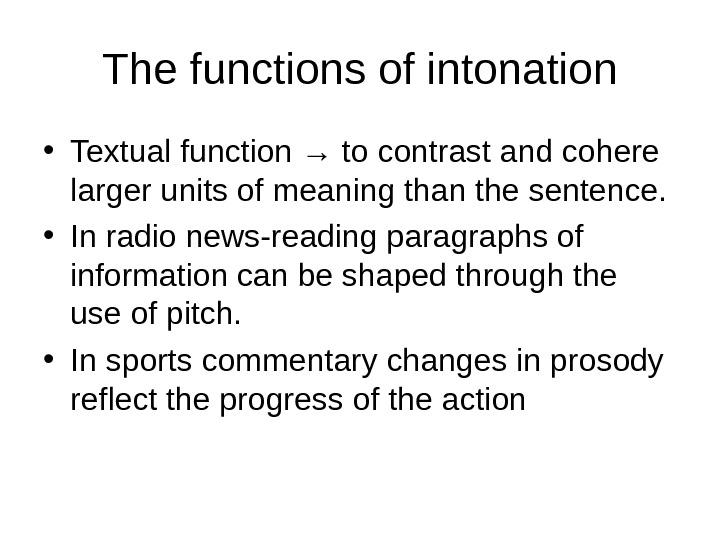Intonation in English Intonation • a




















- Размер: 37.5 Кб
- Количество слайдов: 19
Описание презентации Intonation in English Intonation • a по слайдам
 Intonation in English
Intonation in English
 Intonation • a language universal. • There are no languages which are spoken without any change of prosodic parameters but intonation functions in various languages in a different way.
Intonation • a language universal. • There are no languages which are spoken without any change of prosodic parameters but intonation functions in various languages in a different way.
 Two main approaches • a contour analysis • a grammatical approach
Two main approaches • a contour analysis • a grammatical approach
 A contour analysis • represented by a large group of phoneticians: H. Sweet, D. Jones, G. Palmer, L. Armstrong, I. Ward, R. Kingdon, J. O’Connor, A. Gimson and others. • the smallest unit to which linguistic meaning can be attached is a tone-group (sense-group)
A contour analysis • represented by a large group of phoneticians: H. Sweet, D. Jones, G. Palmer, L. Armstrong, I. Ward, R. Kingdon, J. O’Connor, A. Gimson and others. • the smallest unit to which linguistic meaning can be attached is a tone-group (sense-group)
 A contour analysis • intonation consists of basic functional «blocks» • Intonation is a layer that is superimposed on the lexico-grammatical structure
A contour analysis • intonation consists of basic functional «blocks» • Intonation is a layer that is superimposed on the lexico-grammatical structure
 Criticism • pay much attention to these «blocks» but not to the way they are connected • the aim of communication determines the intonation structure, not vice versa
Criticism • pay much attention to these «blocks» but not to the way they are connected • the aim of communication determines the intonation structure, not vice versa
 A grammatical approach • worked out by M. Halliday. • The main unit of intonation is a clause. • Intonation is a complex of three systemic variables: tonality, tonicity and tone, which are connected with grammatical categories
A grammatical approach • worked out by M. Halliday. • The main unit of intonation is a clause. • Intonation is a complex of three systemic variables: tonality, tonicity and tone, which are connected with grammatical categories
 A grammatical approach • Tonality marks the beginning and the end of a tone-group. • Tonicity marks the focal point of each tone-group. • Tones can be primary and secondary. They convey the attitude of the speaker. • is based on the syntactical function of intonation.
A grammatical approach • Tonality marks the beginning and the end of a tone-group. • Tonicity marks the focal point of each tone-group. • Tones can be primary and secondary. They convey the attitude of the speaker. • is based on the syntactical function of intonation.
 K. Pike • founder of the American school of intonation • considers «pitch phonemes» and «contours» to be the main units of intonation. • describes different contours and their meanings • but «meaning» stands apart from communicative function of intonation.
K. Pike • founder of the American school of intonation • considers «pitch phonemes» and «contours» to be the main units of intonation. • describes different contours and their meanings • but «meaning» stands apart from communicative function of intonation.
 Russian linguists • on perception level intonation is a complex, a whole, formed by significant variations of pitch, loudness and tempo closely related. • speech timbre is the fourth component of intonation
Russian linguists • on perception level intonation is a complex, a whole, formed by significant variations of pitch, loudness and tempo closely related. • speech timbre is the fourth component of intonation
 Russian linguists • Neither material form of speech timbre nor its linguistic function has been thoroughly described. • speech timbre definitely conveys certain shades of attitudinal or emotional meaning • But there is no good reason to consider it alongside with the three prosodic components of intonation, i. e. pitch, loudness and tempo.
Russian linguists • Neither material form of speech timbre nor its linguistic function has been thoroughly described. • speech timbre definitely conveys certain shades of attitudinal or emotional meaning • But there is no good reason to consider it alongside with the three prosodic components of intonation, i. e. pitch, loudness and tempo.
 Russian linguists • the term prosody embraces the three prosodic components and substitutes the term intonation (M. Sokolova and others) • the term is widely used in linguistic literature, it causes no misunderstanding and, consequently, it is more adequate
Russian linguists • the term prosody embraces the three prosodic components and substitutes the term intonation (M. Sokolova and others) • the term is widely used in linguistic literature, it causes no misunderstanding and, consequently, it is more adequate
 • Many foreign scholars (A. Gimson, R. Kingdon) restrict the formal definition of intonation to pitch movement alone + allowing variations of loudness.
• Many foreign scholars (A. Gimson, R. Kingdon) restrict the formal definition of intonation to pitch movement alone + allowing variations of loudness.
 • the most important prosodic effects are those conveyed by the linguistic use of pitch movement, or melody (D. Crystal). • But not possible to restrict “intonation” by the pitch parameters only → generally all the three prosodic parameters function as a whole though in many cases the priority of the pitch parameter is quite evident.
• the most important prosodic effects are those conveyed by the linguistic use of pitch movement, or melody (D. Crystal). • But not possible to restrict “intonation” by the pitch parameters only → generally all the three prosodic parameters function as a whole though in many cases the priority of the pitch parameter is quite evident.
 The functions of intonation • no general agreement • three functions of intonation: delimitating, integrating and semantic(T. M. Nikolayeva) • the semantic function → the primary and syntactic and stylistic functions → the secondary functions (L. K. Tseplitis) • main functions of intonation: communicative, distinctive (or phonological), delimitating, expressive, appellative, aesthetic, integrating (N. V. Cheremisina)
The functions of intonation • no general agreement • three functions of intonation: delimitating, integrating and semantic(T. M. Nikolayeva) • the semantic function → the primary and syntactic and stylistic functions → the secondary functions (L. K. Tseplitis) • main functions of intonation: communicative, distinctive (or phonological), delimitating, expressive, appellative, aesthetic, integrating (N. V. Cheremisina)
 The functions of intonation • D. Crystal • Emotional function → to express attitudinal meaning — sarcasm, surprise, impatience, delight and other semantic nuances. • Grammatical function → to identify grammatical structure in speech, performing a role similar to punctuation → clause and sentence often depend on intonation.
The functions of intonation • D. Crystal • Emotional function → to express attitudinal meaning — sarcasm, surprise, impatience, delight and other semantic nuances. • Grammatical function → to identify grammatical structure in speech, performing a role similar to punctuation → clause and sentence often depend on intonation.
 The functions of intonation • Informational function → to draw attention to what meaning is given and what is new in an utterance → the word carrying the most prominent tone in a contour carries new information.
The functions of intonation • Informational function → to draw attention to what meaning is given and what is new in an utterance → the word carrying the most prominent tone in a contour carries new information.
 The functions of intonation • Textual function → to contrast and cohere larger units of meaning than the sentence. • In radio news-reading paragraphs of information can be shaped through the use of pitch. • In sports commentary changes in prosody reflect the progress of the action
The functions of intonation • Textual function → to contrast and cohere larger units of meaning than the sentence. • In radio news-reading paragraphs of information can be shaped through the use of pitch. • In sports commentary changes in prosody reflect the progress of the action
 The functions of intonation • Psychological function → to organize speech into units that are easier to perceive and memorize. • Indexical function → to serve as a marker of personal or social identity → lawyers, preachers, sports commentators, army sergeants are readily identified through their distinctive prosody.
The functions of intonation • Psychological function → to organize speech into units that are easier to perceive and memorize. • Indexical function → to serve as a marker of personal or social identity → lawyers, preachers, sports commentators, army sergeants are readily identified through their distinctive prosody.

